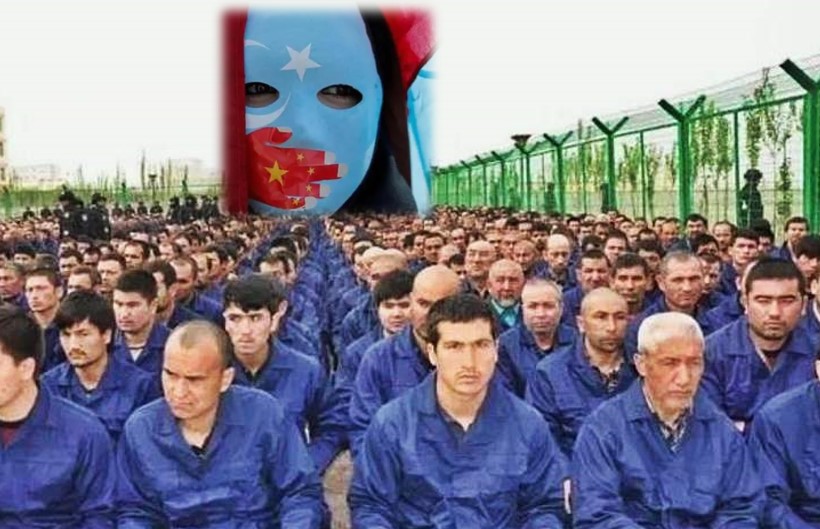September 21 2024
Since the occupation of East Turkestan by communist China in 1949, systematic policies of forced assimilation and repression have been imposed on Muslim Uyghurs and other Turkic peoples. The rights of Uyghurs, Kazakhs, Kyrgyz, and other Turkic Muslims have been continuously violated, their democratic freedoms stripped away, and their religious practices suppressed.
Over the years, this oppression has only intensified, culminating in genocide from 2014 onwards. The Chinese Communist Party’s (CCP) Belt and Road Initiative (BRI), aimed at expanding its economic hegemony, has been a primary justification for the eradication of Muslim Uyghurs in East Turkestan. Serving as a crucial transit hub for the BRI’s economic corridors from China to Central Asia, the Middle East, and Europe, East Turkestan has been subjected to systematic assimilation and genocide as part of the CCP's plan to fully "Sinicize" the region and eliminate the Uyghur presence. Under this policy, internment camps were constructed, where Uyghurs were imprisoned in masse. Under various pretexts, the Chinese government has detained millions of Muslim Uyghurs and other Turkic peoples in these camps, forcing them to renounce their faith and cultural identity while subjecting them to intense political indoctrination.
Reports from international media and testimonies from survivors have documented widespread manipulation, torture, sexual abuse, and other forms of exploitation designed to break the detainees physically and mentally. Chinese authorities have also implemented forced birth control measures and sterilization on Uyghur women to curb population growth. Many Uyghurs youth have been forcibly transferred to Chinese provinces for slave labor in factories. Furthermore, the CCP has aimed to erase Islam from the lives of Uyghurs, criminalizing all Islamic practices and using them as pretexts for detaining Uyghurs.
As we reach 2024, it marks a decade since the Chinese government officially began its genocide policy against the Uyghurs in 2014. Over these ten years, the Uyghurs have faced some of the most severe human rights violations since World War II, including the imprisonment of millions, forced separation of families, sterilization, forced marriages, forced labor, restrictions on the Uyghur language and culture, criminalization of religious practices, and the destruction of traditional Uyghur homes, mosques, and cemeteries. This article offers a brief overview of the various aspects of the Uyghur genocide over the past decade.
The Genesis of Genocide
The seeds of the Uyghur genocide were sown long before 2014. The CCP’s occupation of East Turkestan in 1949 marked the beginning of an unrelenting campaign to suppress Uyghur culture, religion, and identity. Renamed Xinjiang, meaning "new frontier," East Turkestan became a focal point of China’s expansionist policies. The situation worsened in 2014 with the launch of the “Strike Hard” campaign, which led to the establishment of internment camps, forced labor, and other forms of persecution.
Internment Camps: The Epicenter of Atrocity
The construction of these camps peaked in 2017, with millions of Uyghurs and other Turkic people detained under various pretexts. Surrounded by high walls, watchtowers, and armed guards, these camps resemble prisons more than educational facilities. Testimonies from survivors reveal a horrifying reality. While the Chinese government has admitted to the existence of these camps, it has not disclosed the number of detainees. However, in August 2018, the UN Committee on the Elimination of Racial Discrimination stated that it had credible information suggesting over a million Uyghurs were being held in these camps. Survivors like Gulbahar Haitiwaji have recounted how detainees caught speaking Uyghur were punished by being confined to “tiger chairs” for up to 72 hours. Another survivor, Qelbinur Sidik, witnessed mass rapes and forced injections that interrupted menstrual cycles. Tursunay Ziyawudun, who spoke at the International Religious Freedom Summit, described living in constant fear, stating, “The sounds of screams and cries always filled the air; we feared our turn would come next.” Ziyawudun and other Uyghur women were subjected to systematic sexual abuse by camp guards. She vividly recalls, “Once, three Han police officers, overseen by a man in a suit and mask, raped me and another young woman. Such brutalities were widespread; women sometimes returned close to death or never returned at all.” Another example is Miyessar Muhedamu, a Uyghur woman detained in March 2017 because she had studied Arabic in Egypt in her youth. Her husband, Sadirzhan Ayupov, and their three children have not seen her since.
Forced Labor: Enslavement of Muslim Uyghurs
Forced labor is another pillar of the Uyghur genocide. Under the guise of relocating “excess labor,” Chinese authorities have established an extensive forced labor system by transferring Uyghur youth to Chinese provinces. In 2020, over 80,000 Uyghurs were forcibly taken to factories across China, where they faced threats of detention, excessive working hours, and constant surveillance. The products made through Uyghur forced labor range from electronics to textiles, implicating numerous global brands. This system extends even to the mining sector, where Uyghurs are coerced into working under dire conditions. A report by the U.S.-based think tank C4ADS revealed that major U.S. companies indirectly source gold linked to forced labor from mines in East Turkestan. By exploiting Uyghur labor to fuel its economic ambitions, the Chinese authorities have turned genocide into a profitable enterprise.
Harvesting of So-called "Halal" Organs
One of the most chilling aspects of the Uyghur genocide is forced organ harvesting. Reports since 2000 have documented state-approved organ procurement from prisoners in China. With the establishment of internment camps, Uyghurs have become the primary source of organs. Gulbahar Jelil, who spent 16 months in a detention center in Urumqi, reported that all detainees underwent general medical examinations. The detention center had a large hospital where detainees were tested weekly. Many women never returned after being taken from their cells. Other survivors, including Mihrigul Tursun, Zumrat Dawut, and Omir Bekali, have reported similar incidents.
The bodies of deceased Uyghurs are not returned to their families but are buried under police supervision. Special airport corridors have been opened in areas like Kashgar to facilitate organ transfer. Enver Tohti, a former surgeon from East Turkestan, recounted being ordered to remove
organs from a living prisoner. Testimonies from survivors reveal that detainees are subjected to forced medical tests, including blood tests and ultrasounds, to assess their suitability for organ harvesting. To facilitate this dark trade, the Chinese government has created the world’s largest DNA database by collecting DNA from millions of Uyghurs.
The Chinese Communist Party targets wealthy Muslim communities for organs harvested from Uyghur Muslims. Investigations by Korea-based broadcaster Chosen 7 revealed that many people from Saudi Arabia seek “halal organs” from Uyghur Muslims. The channel’s investigation into organ tourism showed people from Saudi Arabia waiting at a hospital in Tianjin, China, for “halal organs.” China sells “halal organs” taken from Muslim Uyghurs to rich Islamic countries, and some hospitals have built prayer rooms and even prepared halal meal menus.
Forced Eradication of Uyghur Generations through Birth Control
Chinese authorities have implemented brutal birth control policies to curb the growth of the Uyghur population. Uyghur women are subjected to forced sterilization, IUDs, and abortions, while Uyghur men of reproductive age are targeted for imprisonment. In East Turkestan, IUD use reached 80% in 2018, compared to an average of 1.8% in China. Birth rates in Uyghur-majority areas plummeted by 84% in 2018 alone. The stories of survivors like Qelbinur Sidik and Tursunay Ziyawudun reveal the brutal extent of this policy. Sidik was forced to participate in the sterilization of Uyghur women, while Ziyawudun described how unknown drugs were injected into female detainees, stopping their menstrual cycles. The actions of the Chinese government constitute a clear violation of the 1948 Convention on the Prevention and Punishment of the Crime of Genocide.
Erasure of Uyghur Children’s Religious and National Identities in Boarding Schools
Chinese authorities have also targeted Uyghur children whose parents are detained in internment camps. These children are sent to state-run boarding schools and orphanages, where the aim is to assimilate them into Chinese culture, erasing their language, religion, and identity. The environment in these institutions is hierarchical and harsh, with children subjected to mental and physical abuse.
Testimonies from children who have escaped these schools reveal the extent of the cruelty. Lutfullah Kuchar, who arrived in Turkey in 2019, recounted how teachers frequently beat them and forced them into stressful positions. The Chinese regime aims to raise Uyghur children as loyal soldiers of the communist party, erasing their cultural and religious heritage.
China’s War Against Islam
China's war on Islam is one of the most barbaric aspects of the Uyghur genocide. Authorities have banned religious education, persecuted religious scholars, burned Qur'ans, demolished mosques, and criminalized Islamic practices. The streets of East Turkestan are filled with symbols of oppression, with mosques turned into tourist attractions or destroyed entirely. The persecution of Muslims in East Turkestan has become a dark chapter in modern history, exposing the CCP's complete disregard for human rights.
The destruction of cultural heritage
The destruction of cultural heritage is an important component of the Uyghur Genocide. Chinese authorities destroyed mosques, cemeteries, and pilgrimage sites, erasing traces of Uyghur history and culture. An estimated one in three mosques in Xinjiang have been destroyed, mostly since 2017, according to a report by the Australian Strategic Policy Institute (ASPI). The Chinese communist administration has also targeted sacred sites such as the Kargılık Grand Mosque and the Sultanim Cemetery in Hotan. The destruction of these sites is part of a broader effort to disperse Uyghur communities and disrupt cultural transmission. The Chinese government justifies these actions as urban development, but the real intention is to erase Uyghur identity and history.
In conclusion, it must be stated that the Uyghur Genocide is one of the most terrible human rights violations of the 21st century. The Chinese government's systematic campaign of persecution, assimilation and genocide has caused great suffering for the Uyghur people. The international community must act urgently to stop this atrocity and hold the perpetrators accountable. The stories of survivors like Miyessar Muhedamu, Gulbahar Haitiwaji, and Qelbinur Sidik are a stark reminder of the horrors Uyghurs face. It is our common responsibility to ensure that their pain is not forgotten and justice is served.
Executive Director of Center for Uyghur Studies

